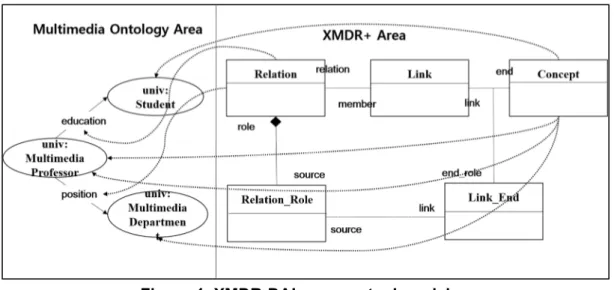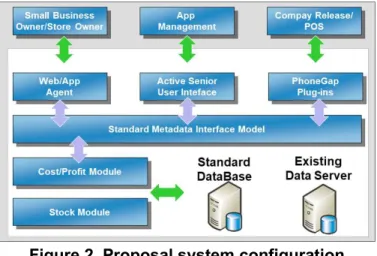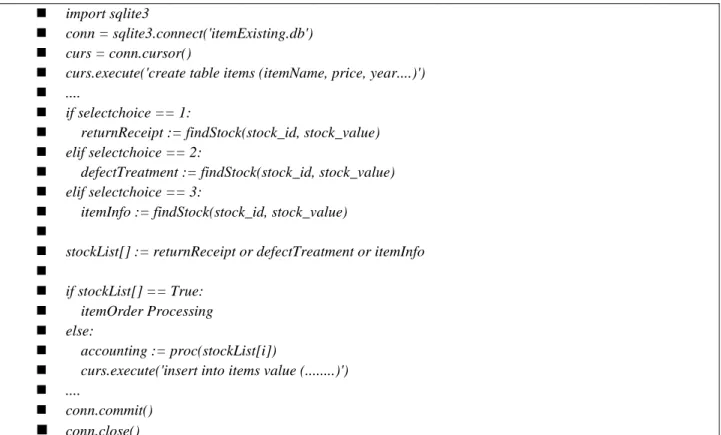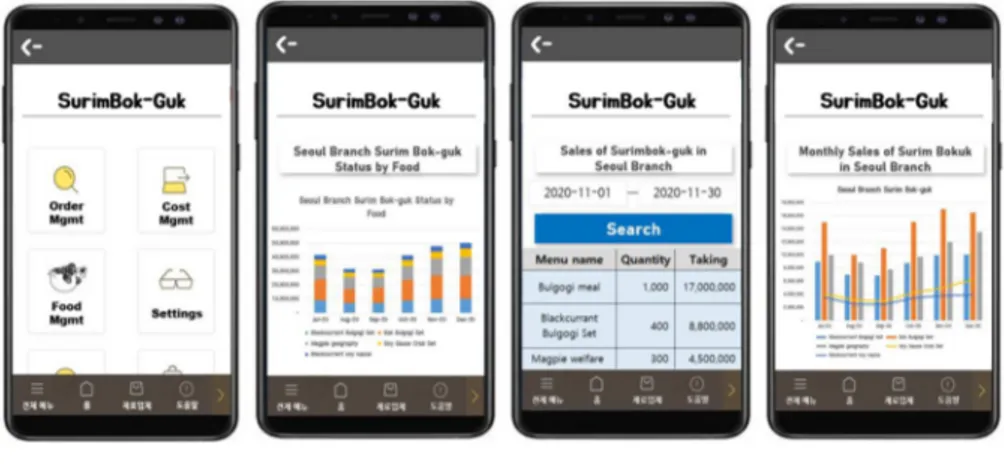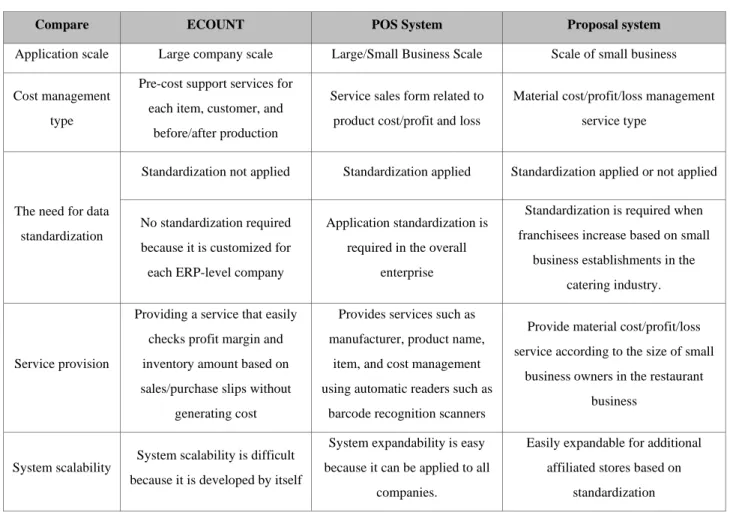Metadata model-centered cost management app for small business owners in the
restaurant business in O2O environment
Gi-Hwan Ryu* and Seok-Jae Moon**
* Professor, Department of Tourism Industry, Graduate School of Smart Convergence, Kwangwoon
University, Korea
** Professor, Department of Information Security Engineering, Institute of Information
Technology, KwangWoon University, Korea
E-mail: {allryu, msj8086}@kw.ac.kr
Abstract
In this paper, we propose a system that allows small business owners focusing on the restaurant business to easily understand the management situation, and to manage the operation and management centering on the cost of food materials and profits and losses. In general, the metadata structure is different depending on the POS system, so it is necessary to first develop a standardized metadata model for a food material cost management system for small business owners in various industries. For that reason, the system proposed in this paper was applied to the cost management app by referring to the development of a data model using the metadata standard. In addition, in order to implement a cost profit/loss management system for small business owners in the restaurant industry, it was designed to support standardized metadata models from various types of POS systems, and is a hybrid app that can support a smart environment. Interface) was configured.
Keywords: O2O, Metadata Model, XMDR, Restaurant Busines.
1. Introduction
In the case of the Korean industry, retail and service industries are on a decreasing trend, but the number of catering companies continues to increase at 58.6%. Small business owners in the catering industry play a very important role as members of the national economy [1]. However, in terms of employment, production and economics, the foundation for self-reliance is very difficult. In this social situation, it is necessary to accurately grasp the current management situation in order for small businesses centered on the restaurant business to achieve economic independence and sustainable growth. And quick management improvement work should be carried out [2]. However, most small business owners centered on the catering industry are not properly aware of the management and operation status of their companies. For example, there are many cases in which items such as basic break-even point, monthly food material cost, menu cost, and monthly profit and loss calculation are not properly managed. In addition, small business owners in the restaurant industry are rapidly aging, so they are not familiar with using PCs or smartphones. They are unable to adapt to the rapidly changing food service industry market, and the preparation of system-based systematic management is insufficient [3].
IJIBC 21-2-8
Manuscript Received: February. 10, 2021 / Revised: February. 15, 2021 / Accepted: February. 20, 2021 Corresponding Author: msj8086@kw.ac.kr
Tel: +82-10-7753-8086, Fax: +82-2-916-4751
In this paper, we propose a system that can manage the key factors of cost and profit of ingredients based to allow easy and fast operation situation of food materials cost management to identify which accounts for most part of the expenses of small business engaged in the Restaurants. This proposed system is designed based on UX (User Experience) [4] as a way to solve the difficulties of using the system due to the aging of business owners. In addition, it was designed with a screen that can be easily used by active senior owners. In particular, the metadata structure is different for each POS system in operation. For a cost management system for small business owners in various restaurants, it is necessary to develop a standardized metadata reference model. The data model developed using the metadata standard was referenced and applied to the cost management app. In this paper, basically, it is designed to support standardized metadata models from various types of POS systems. And the UI was configured as a hybrid app that can support both web and mobile environments at the same time. In addition, according to the popularization of smartphones, it was configured appropriately for O2O environment [5].
2. Metadata Registry-Data Access & Integration
<Figure 1>, eXtended Metadata Registry-Data Access & Integration was an agent to solve metadata schema and data structure and semantic collision according to data integration using XMDR [6], which was an extended concept of MDR [7], saving metadata of relational database to object-oriented database. In other words, it was storage combining MDR with ontology to prevent collision between schema structures of scattered data and instances. The XMDR-DAI+ applied collaboration system provided a data integration service for interoperation between local systems using a single view type of application. In addition, it provided association information between the instances using concepts of metadata registry and ontology thesaurus for data integrity and retrieval service. In addition, it had a function of mapping-converting of global schema and local schema in data sharing and exchange using entity schema between local databases, suggested standards required for constructing queries in collaboration using query-based workflow for data interoperation, and provided conversion mechanism and processing module of scattered queries in data migration for functions of replication, alignment, and merging.
Figure 1. XMDR-DAI+ conceptual model
A conceptual XMDR model with key relations in the Figure. 1 showed a good example of ontology resource management. XMDR-DAI+ was composed of and defined by various classes in Registered_Item like as Relation and
Concept (map to univ: Multimedia Professor, univ: Student, univ: Multimedia Department). Among the classes, Relation class formed inheritance relations with concept class and played a role of property reference concerning Binary_Relation class. It defined relations between concepts and concept classes defining relations between concepts and semantic standards in the same class such as Relation_Role, Link, and Link_End. On the other hand, relation class identified relations between Link class and Relation_Role class, and Link_End class identified relations between Link class and Concept class. Thus, Link and Link_End class explained and expressively distinguished more than one component of Relation. In addition, XMDR-DAI+ was designed to consider the scope of relations between levels of instances and concepts of ontology thesaurus.
3. Configuration of cost management app centered on metadata model
3.1. Proposal system configurationIn this paper, we propose a cost management system centered on a metadata reference model for small businesses engaged in restaurant business in O2O environment, as shown in <Figure 2>. This is based on a hybrid app that applies PhoneGap technology using standard metadata and provides functions for cost management and profit/loss analysis. The following describes the components of the system proposed in this paper. In this paper, the proposed system is composed of Web/App agent, Active Senior UI, PhoneGap Plug-ing, Standard Metadata Interface Model, Cost/Profit Module, and Stock Module.
Figure 2. Proposal system configuration
Web/App Agent. This component refers to application software that can be used in a web browser over the
Internet or intranet. In this paper, it is an agent that supports cost management system to users through various media such as web browser or mobile app environment.
PhoneGap Plug-Ins. This component supports the development of hybrid mobile apps using the PhoneGap
plug-in technology, and PhoneGap is one of the hybrid app development frameworks. This makes it possible to call and use various functions and resources of the phone from a web page, and these functions are provided as called plug-ins.
Active Senior UI. The active senior UI component uses the proposed system by senior owners of small
business enterprises. This is a function that supports easy adaptation and use in a mobile-based hybrid app environment.
Standard Metadata Interface Model. The data used for POS is stored in the existing database. At this time,
since data structures such as table names, column names, and table structures are different for each force brand, a standardized model that can be connected regardless of force is required. The scope of the standard metadata reference model in this paper is to define a standard data model for building a profit and loss cost management
system.
import sqlite3
conn = sqlite3.connect('emar.db') curs = conn1.cursor()
curs.execute('create table xmdr (xmdrScheam, xmdrValue, xmdrLoc....)') metadata[] := findXMDR(ex_id, ex_value)
schema[] := findXMDR(metadata[], ex_value) XMDR_Select = search.XMDR_Infor XMDR_Ontology = search.Ontology_Info for i in XMDR_Select: schemaTable := i.table schemaField := i.field schemaValue := i.value schemaLocal := i.local
standaradMeataInfo:= proc(metadata[], schema[])
Cost/Profit Module. This component is a module that analyzes the cost and profit/loss for each item of a small
business in the restaurant business and provides it to the app. The analyzed cost and profit and loss information is stored in its own database.
import sqlite3
conn1 = sqlite3.connect('items.db') conn2 = sqlite3.connect('standard.db') curs1 = conn1.cursor()
curs2 = conn1.cursor()
curs1.execute('create table items (itemName, price, year....)') curs2.execute('create table items (itemName, price, year....)') ....
if selectchoice == 1:
itemPriceInfo := findItem(item_id, item_value, itemPrice) elif selectchoice == 2:
itemSelInfo := findItem(item_id, item_value, itemSelPrice) elif selectchoice == 3:
extenalInfo := findItem(item_id, item_value, item, extenalPrice) itemList[] := itemPriceInfo or itemSelInfo or extenalInfo if itemList[] == True:
itemPrice Processing itemProfit/Loss Processing else:
accounting := proc(itemList[i])
curs1.execute('insert into items value (...)') curs2.execute('insert into items value (...)')
Stock Module. This component is a module that analyzes and identifies inventory for each item by small
business enterprise and provides it to the app. Inventory information for each item analyzed is stored in its own database.
import sqlite3
conn = sqlite3.connect('itemExisting.db') curs = conn.cursor()
curs.execute('create table items (itemName, price, year....)') ....
if selectchoice == 1:
returnReceipt := findStock(stock_id, stock_value) elif selectchoice == 2:
defectTreatment := findStock(stock_id, stock_value) elif selectchoice == 3:
itemInfo := findStock(stock_id, stock_value)
stockList[] := returnReceipt or defectTreatment or itemInfo
if stockList[] == True: itemOrder Processing else:
accounting := proc(stockList[i])
curs.execute('insert into items value (...)') ....
conn.commit()
conn.close()
3.2. Standard metadata model structure
In the metadata model <Figure 3>, the item and data classification system of the service definition is used. This defines the data that needs to be shared and shows the logical data that needs to be managed in the small franchise cost management system.
4. Apply cases and comparative analysis
4.1. Apply cases
<Figure 3> is the cost management app interface when the application is executed. Interface 1 is the entire menu of the cost management app and is divided into order management, cost management, food material management, and setting. Interface 2 allows you to check the monthly sales status of each company's menu of the Seoul branch forestry bureau, and it is output as a graph by applying Google API. Interface 3 is a screen showing the monthly sales status of Surimbok-guk at the Seoul branch, and Interface 4 is a screen showing information related to the sales status of each menu.
Figure 4. Apply Interface
4.2 Comparative analysis
In this paper, the proposed system for small business owners and other similar systems were compared and analyzed. <Table 1> compares the proposed system and ECOUNT, POS system and application scale, cost management type, data standardization necessity, service provision, and system scalability. ECOUNT is a system that provides support for pre-costs by item, by customer, and before and after the production of a product as the size of a large company. As it is an ERP-level customized system for each company, metadata-based standardization is unnecessary. However, it is a structure that provides a service that easily checks the margin and inventory amount based on sales and purchase slips without generating cost. Since this is self-developed, it is difficult to expand with other systems. POS is a system used by large enterprises and SMEs as a whole. As a form of selling services related to product cost and profit/loss, it is essential to apply metadata-based standardization. In addition, it provides services such as manufacturer, product name, item, and cost management using automatic readers such as barcode recognition scanners. This can be applied to all companies, and system scalability is easy. The system proposed in this paper is the scale of small business owners in the restaurant business. It is proposed in a simple form that only services material cost and profit/loss management. Therefore, the application of standardization based on metadata is flexible. It is a structure that needs standardization when increasing companies targeting small business enterprises. The service provided by the proposal system provides simple services such as material cost and profit and loss according to the size of small business owners. Because it is composed based on standardization, it is easy to expand when the number of companies increases. However, when the size or company of a small business enterprise increases, the service function that supports it should be expanded accordingly.
Table 1. Comparison of other systems
Compare ECOUNT POS System Proposal system
Application scale Large company scale Large/Small Business Scale Scale of small business
Cost management type
Pre-cost support services for each item, customer, and
before/after production
Service sales form related to product cost/profit and loss
Material cost/profit/loss management service type
The need for data standardization
Standardization not applied Standardization applied Standardization applied or not applied
No standardization required because it is customized for each ERP-level company
Application standardization is required in the overall
enterprise
Standardization is required when franchisees increase based on small
business establishments in the catering industry.
Service provision
Providing a service that easily checks profit margin and inventory amount based on sales/purchase slips without
generating cost
Provides services such as manufacturer, product name,
item, and cost management using automatic readers such as
barcode recognition scanners
Provide material cost/profit/loss service according to the size of small
business owners in the restaurant business
System scalability
System scalability is difficult because it is developed by itself
System expandability is easy because it can be applied to all
companies.
Easily expandable for additional affiliated stores based on
standardization
5. Apply cases and comparative analysis
In this paper, small business owners engaged in the restaurant industry can quickly and easily grasp the management situation. It is for small business owners in the restaurant business in an O2O environment to manage food material costs and profits and losses. So, we proposed a cost management app-based system centered on the metadata reference model. Existing systems have been difficult to apply to various small business owners in the restaurant industry due to the heterogeneous problem of the metadata schema structure that differs from system to system. In order to solve this problem, a standard meta-model design based on metadata was constructed by applying a food material cost management system. In addition, a metadata model using a standard metadata model based on metadata was implemented and applied to a cost management app. In addition, in this paper, the UI was configured as a hybrid app to support the smart environment for the interface of the app-based profit and loss cost management system for small business owners in the catering industry. The reason for configuring the UI in the format of a hybrid app is to be applied regardless of the device and operating system, and it was implemented using HTML5 and Jquery techniques. In addition, by using synchronous and asynchronous plug-in execution mechanisms, we minimized the action reaction time when running the app.
Acknowledgement
References
[1] Ki Woong Kim, Jaesung James Park, Joon Yeop Kim, "A Study on the Promotion of Digital Transformation for Micro Enterprises: Focusing on the Factors Influencing Digital Transformation", orea Business Review, No.2 pp.131-150, 2021.
DOI: 10.17287/kbr.2020.24.0.131
[2] Songchoon Park, and Yuri Lee. "Impact Analysis of the Influence of Small Business Owners’ Entrepreneurial Characteristics on the Management Performances: Focusing on the Mediation of Social Capital", The Journal of Humanities and Social Sciences, Vol.12, No.1.1, 2021: pp.655-668.
DOI http://dx.doi.org/10.22143/HSS21.11.2.45
[3] Ku, Woongmo. "The Effect of Adversity Quotient of Small business CEOs on Customer Orientation: Mediating Effect of Entrepreneurial Orientation." Asia-Pacific Journal of Business Venturing and Entrepreneurship 15.3,2020,pp.103-119.
DOI: https://www.koreascience.or.kr/article/JAKO202019854293434.pdf [4] www.initiondata.kr/SeniorUX
[5] PARK, Hyun-Sung, "A study on the O2O Commerce Business Process with Business Model Canvas", Journal of Distribution Science, Vol.18 Issue.5, 2020, pp.89-98.
[6] Choi, Sung-Uk, and Seok-Jae Moon. "A Study on Extension of XMDR-DAI Considering the Relationships between Classes." International Journal of Applied Engineering Research 12.20,2017, pp.9879-9884. DOI: http://www.ripublication.com/ijaer17/ijaerv12n20_87.pdf
[7] ISO/IEC 11179-3, Information technology — Metadata registries (MDR) — Part 3: Registry metamodel and basic attributes.
